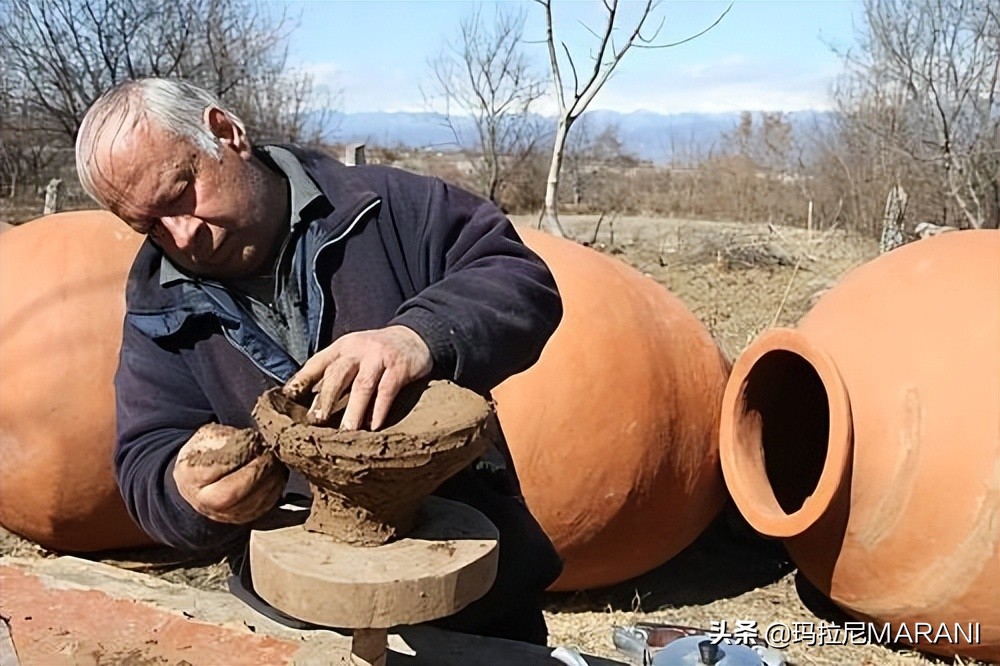Georgia, the birthplace of the world's wines, has a long history of winemaking and is the only country in the world that has been using Qvevri to make wine uninterrupted from ancient times to modern times.
(1) The originator of clay pot winemaking vessels
The traditional clay pot brewing method, or Qvevri method, is the earliest method of wine making in human history. It originated in the Caucasus and spread around the world about 5,000 years ago. The oldest clay pot found by archaeologists in Georgia was made about 7,000 years ago and looks almost exactly like the clay pot used for local winemaking today.

(Optional) Image description
Georgian Qvevri clay pots can only be made using only a few specific clays, and only a limited number of villages can produce them. After shaping, the potter burns grease or beeswax, forming a film inside the clay pot. A clay pot can be used for decades or even hundreds of years, and it is crucial to the quality of the wine.
(2) Qvevri VS Modern Craftsmanship
In ancient times, the construction of a wine cellar was first required to bury the Qvevri in the ground. The foundation of the cellar is deeper than the average building, and after being placed in the Qvevri, it is fixed with lime and rubble around it, and then the soil is buried in the neck of the Qvevri, with a capacity of up to 3,000 liters.
(Optional) Image description
After the wine grapes are harvested, they are put into a wooden crusher, and the juice is pressed into Qvevri with the grape stems and skins. The grapes are fermented at a constant temperature of 13-15 degrees Celsius in Qvevri, and the contact time between the peel and the wine is greatly lengthened by repeated agitation and downward pressure.
After fermentation, the grape skins, seeds and stems sink to the bottom of the tank, which is known locally as Chacha. After malolactic fermentation, the wine and Chacha remain in the Qvevri jar to age, the mouth of the jar is sealed with clay and mud, and the age and the amount of Chaha vary from winery to winery.
(Optional) Image description
This large clay pot, buried deep in the ground for fermentation and storage of wine, can store wine for 50 years. Modern breweries require a range of expensive and complex equipment to reach the conditions of production and storage, which Qvevri can easily achieve.
(3) Let the grapes return to the soil
The earth contributes to the grapes, and the Qvevri law of winemaking brings the grapes back to earth.
New oak barrels often add some oak barrel features to the wine, which does not make the wine play out its original characteristics, while Qvevri will not. The wine is cultivated in a cool and quiet environment, which perfectly expresses the stylistic characteristics of the grapes themselves, without adding other flavors at all.
(Optional) Image description
Many of Qvevri's red and white wines have varying degrees of peel contact. The duration of contact depends on the winemaker. Depending on the vintage and the style of the final need, the winemaker will decide whether to shorten or end the peel contact.
For winemakers around the world, Qvevri is a way of symbolizing nature.
(4) Advantages of Qvevri brewing
The main advantage of using Qvevri winemaking is that the wine remains at a constant temperature for several years during the cold cycle. Not only does it play an important role in the winemaking process, it is also a very good storage vessel.
Tablet description
During storage, since Qvevri is conical, the wine is not too much adversely affected by seeds and stems. During the aging and fermentation process, grape seeds, stems and grape residues are deposited at the bottom of the tank, and the wine and sediment cover them for several months. The resulting wines are brilliant in colour and vaguely convey dried apple and walnut aromas, with excellent taste, mellow flavours, rich in tannins and excellent aging potential.
Tablet description
It is said that there is a longevity village in Georgia, and the secret of longevity of the local elderly, in addition to the pleasant natural climate, is to drink wine.
This winemaking process, which has been passed down for more than 8,000 years, was listed by UNESCO as a World Intangible Cultural Heritage in 2013. Wines made in clay pots are unique in the global wine market with their unique vinification process and unique taste.